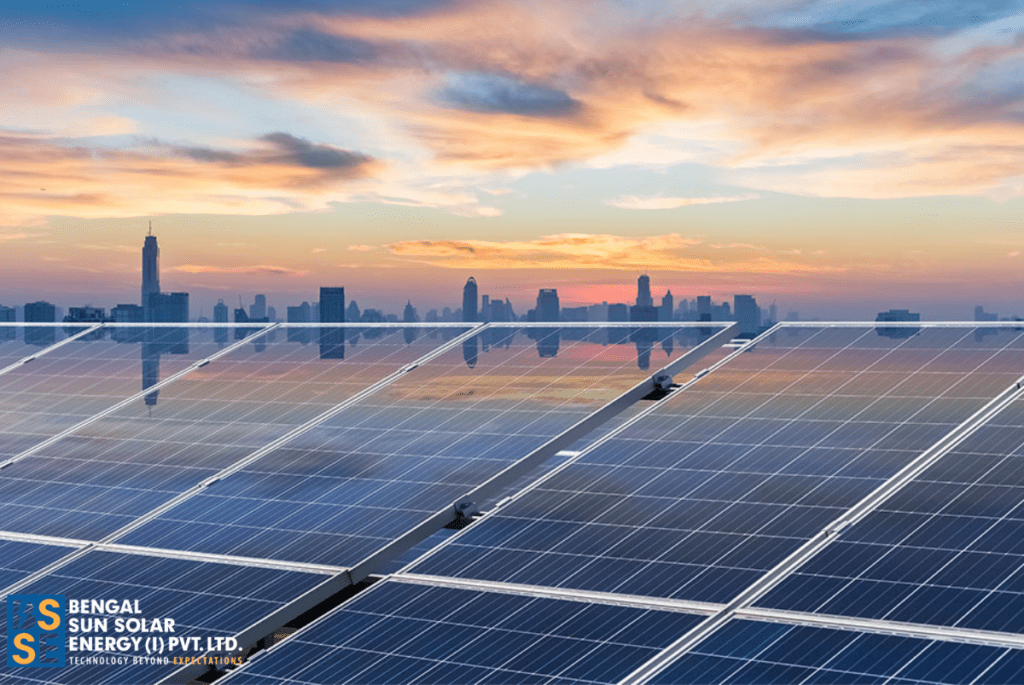PV modules use semiconductor materials to generate dc electricity from sunlight. A large area is needed to collect as much sunlight as possible, so the semiconductor is either made into thin, flat, crystalline cells, or deposited as a very thin continuous layer onto a support material. The cells are wired together and sealed into a weatherproof module, with electrical connectors added. Modern modules for grid connection usually have between 48 and 72 cells and produce DC (Direct Current) voltages of typically 25 to 40 volts, with a rated output of between 150 and 300 Wp.
In order to supply electricity into a mains electricity system, the DC output from the module must be converted to ac at the correct voltage and frequency. An electronic inverter is used to do this. Generally a number of PV modules are connected in series to provide a higher DC voltage to the inverter input, and sometimes several of these ‘series strings’ are connected in parallel, so that a single inverter can be used for 50 or more modules. Modern inverters are very efficient (typically 97%), and use electronic control systems to ensure that the PV array keeps working at its optimum voltage. They also incorporate safety systems as required in the country of use as per specifications from the best on grid solar panel manufacturers in Kolkata.
Many grid connected PV systems are installed on frames which are mounted on the roof or walls of a building. Used in this way the PV does not take up land that could be used for other purposes. Ideally the PV faces towards the equator (i.e. South in the northern hemisphere) but the exact direction is not critical. However, it is important to make sure that there is minimal shading of the PV. The inverter is housed inside the building and connected to the mains electrical supply, usually with a meter to measure the kWh generated. If the PV electricity production exceeds building demand then the excess can be exported to the grid, and vice versa as per the information from the best on grid solar panel manufacturers in West Bengal.
A grid connected system rated at 1 kWp (1000 Wp) has an area of between 5 and 14 m2, depending on the type of semiconductor. If the PV system is installed during construction or refurbishment, it can sometimes be used as part of the building fabric, such as a roof or wall-cladding. Where space and sun are available, large stand-alone PV arrays can be built and connected to the public grid. Grid-connected systems do not usually include batteries for storage, because the mains grid can accept or provide power as needed. However, if rechargeable batteries are included, a grid-connected PV system can be used as a standalone ac supply in the event of a power cut, to allow essential loads to keep working.
By reducing the need for fossil-fuel generation, grid-connected PV cuts greenhouse gas emissions (and other air pollution), because no emissions are produced during PV operation. The best on grid solar panel manufacturers in Kolkata is setting the best standards towards harnessing renewable sources of energy.
PV is the easiest renewable electricity source to incorporate into buildings. The electricity is supplied at the point of use, thus avoiding the losses which occur in electricity distribution. It can be used at any scale – from less than a kWp on an individual home up to MWp scale systems on large public buildings – and is simple and reliable. Because of this, it is a valuable way to raise awareness of electricity supply and use, and helps highlight the potential for renewable energy.
The price of PV modules is decreasing rapidly. Check up the costs with the best on grid solar panel manufacturers in West Bengal. For crystalline cells, new ways of processing silicon and increased volume manufacture are driving down prices. The market share of thin film PV is growing rapidly as materials which have been proved in the laboratory go into volume production, and these promise even greater price reductions. However, there is less potential for price reduction in the ‘balance of system’, and these costs will soon dominate the overall system cost.
Because of the decreasing prices, the rapid growth in the market for grid-connected PV is expected to continue even if government support is reduced. The market will really take off when electricity from PV becomes cheaper than other grid sources. When PV feeds directly into a building supply, this grid-parity price is the consumer purchase price.
